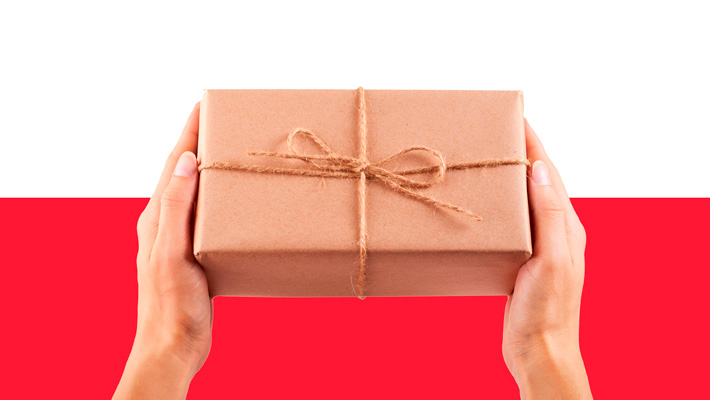Sep 15, 2025
Shipping to Poland: Convenience, Cost, and Culture

In Europe, shoppers view e-commerce and shipping to Poland as a way to take control of their shopping experience. In fact, parcel lockers have become a daily essential for receiving deliveries, where convenience is a major draw. Most users choose lockers because they're always open.
This allows them to pick up packages anytime, whether it's after work or late at night, eliminating the need to wait at home. This freedom transforms errands into quick, hassle-free stops.
Speed is also a significant factor, with most users agreeing that lockers are faster than traditional couriers. Modern deliveries are known for their speed, often arriving by the next day, which builds trust with consumers and households. The security of not having to worry about missed packages and the perception that lockers are a more environmentally friendly option adds to their appeal for those looking to reduce their impact.
Mobile apps streamline the entire process, allowing millions of users to pick up their packages with just a tap, which means no lines or waiting. While this shifts some of the work to the consumer, most people find the independence and peace of mind it provides to be well worth the effort.
You can see this just by looking at the internal domestic shipping market.
“Polish logistics company InPost, the leading parcel locker provider in Europe, now has more lockers abroad than in Poland,” according to TVP World. “The company, which has made inroads into a number of foreign markets, now has 27,300 Automated Parcel Machines (APMS) abroad compared to 27,000 in Poland.”
Cultural Integration Phenomena and Shipping to Poland
Poland’s e-commerce landscape is defined by its widespread embrace of automated parcel lockers and shipping to Poland from the United States, a trend beginning in the mid-2000s.
Today, their lockers, known as Paczkomaty, are so ubiquitous that the term has become a generic word for any parcel locker, much like “Kleenex” is for tissues in the United States. This has made picking up a parcel as commonplace as checking a mailbox.
With more than 27,000 machines across the country, it's rare to be far from a Paczkomat. This accessibility has made them the preferred delivery method for most Polish shoppers, with a recent study showing that 94 percent of online buyers choose InPost's lockers.
This preference is reflected in the market share. InPost holds a commanding 57 percent, far ahead of DPD's 16 percent and Allegro's 9 percent.
The brand's near-universal recognition and integration into daily life have made it the go-to network for major sellers like Amazon.pl. For many, Paczkomaty have evolved from a simple business service into a public good, becoming a normal and trusted part of everyday routines.
“Among parcel collection methods, participants prefer using parcel lockers,” states Poland Weekly. “39% prefer parcel lockers only after a retailer has offered it to them, while 96% of respondents said the reason they preferred this method was that they could pick up their parcels at any time of the day.”
The article adds: “In addition, 64% of respondents said they preferred parcel lockers because they are faster than standard courier services. 56% prefer it because of the location of the machines. Courier drop-off locations were the least preferred method at 53%. Nearly 70% of respondents said they do not or rarely use traditional courier services.”
Comparison to U.S. Model: The Amazon Prime Paradigm
When you’re considering shipping to Poland, it’s helpful to compare the historical context behind delivery networks from an international perspective.
American online shopping is defined by a culture of fast, direct-to-door delivery, a habit largely shaped by Amazon. The company's massive, vertically integrated delivery network handles every part of the process itself, which allows it to ship billions of packages each year.
In one year, it shipped over six billion packages in the United States. This amounts to an average of more than 17 million orders daily.
To achieve this, Amazon built its own fleet of thousands of trucks, vans, and even over a hundred planes, reducing its reliance on companies like UPS and FedEx. The introduction of Prime membership reshaped consumer expectations, making one or two-day delivery the new standard.
This is a particularly challenging feat given the vast distances between homes in the United States, yet Amazon's operation reaches over 80 percent of American households. The logistical challenge of delivering individual packages to over 120 million homes highlights how difficult it is to solve the problem of the final mile — the journey from a local hub to a customer's front porch.
|
Metric |
United States |
Poland |
|
Dominant Last-Mile Model |
Door-to-Door (Amazon Prime) |
Out-of-Home (InPost Paczkomaty) |
|
Primary Driver of Model |
Consumer demand for fast, frictionless, home delivery |
Consumer demand for 24/7 flexibility and security |
|
Packages Delivered by Top Carrier |
6.3B (Amazon Logistics, 2024) |
1.1B (InPost, 2024) |
|
Top Carrier Market Share (by volume) |
26.5% (Amazon Logistics, 2024) |
57% (InPost Paczkomaty, parcel machine market, 2024) |
|
Last-Mile Cost as % of Total |
Up to 75% |
Significantly lower due to consolidation |
|
Average Delivery Time |
3.7 days (e-commerce average, 2024) |
1 day (98% of InPost parcels) |
|
Prevalence of Package Theft |
Widespread (1 in 4 Americans) |
Low/Non-existent for OOH deliveries |
Shipping to Poland and the Problem with Passive Convenience
While many people believe that Americans prioritize fast delivery, the truth is that a significant number of shoppers are willing to wait longer if it means they can get free shipping. For most people, the price of shipping is a bigger concern than the speed of delivery.
However, this reliance on home delivery has created a major problem: porch piracy. This isn't just a minor annoyance; stolen packages accounted for $12 billion in losses last year, with nearly 93 million thefts occurring in 2023.
These thefts don't just frustrate shoppers. They also cost companies money in replacements and make people feel uneasy in their own homes, especially around the holidays.
The pervasive fear of package theft is evident, with nine out of ten Americans worrying about it. This has prompted many to change their routines, opt for store pickups, or install security cameras. It’s an interesting paradox that the same convenience of doorstep delivery also makes it so vulnerable to theft.
Contrasting Logistical Architectures and Psychologies
Shipping to Poland and local logistics in that country versus the United States are fundamentally different. The American system relies on a hub-and-spoke model where the final step, delivering a package to a person's door, is the most expensive, often consuming half or more of the total delivery cost.
This final leg is inefficient, with couriers spending too much time driving between homes. About one in 10 deliveries can miss the recipient on the first attempt, which wastes gas, money, and time.
In contrast, Poland's system avoids these issues by using a dense network of secure parcel lockers across cities. This allows couriers to drop off a large number of packages in a single location, enabling them to handle up to ten times more deliveries per trip and reducing the number of vehicles on the road.
A study in Seattle, WA, confirmed the effectiveness of this approach, showing an almost 80 percent reduction in delivery times and a perfect first-time delivery rate. While the United States continues to invest in a less efficient, workaround-heavy system, Poland designed a unique solution from the start.
The different approaches are rooted in consumer values. American shoppers prioritize convenience, expecting packages to arrive at their door with minimal effort, with “free and fast” delivery being the most important factor. However, this convenience comes with headaches like missing parcels and mix-ups.
Polish shoppers, on the other hand, prioritize control. They are willing to pick up a package from a locker for the safety and convenience this experience offers, allowing them to avoid porch pirates and the stress of waiting for a delivery.
This key difference highlights a contrast between the American approach and the Polish one, with each country's e-commerce system built around what its people value most: convenience or control.
Lessons in Shipping to Poland: A Blueprint
American e-commerce faces two major issues versus shipping to Poland: high last-mile delivery costs and the persistent threat of porch pirates. Poland has found an effective solution.
While companies like Amazon and Walmart have tried using their own branded parcel lockers and pickup towers in the past, these never gained the same traction as Poland's Paczkomaty. Walmart even abandoned its pickup towers in favor of traditional home delivery, which failed to address the core problem.
The key difference in Poland's success was InPost's strategy of creating an open system that any carrier or store could use. This inclusive approach attracted a wide range of retailers and carriers, expanding the network and giving consumers more options. In contrast, a closed, brand-specific system simply cannot achieve the same widespread adoption.
The United States could adopt this model to reduce missed deliveries, combat porch piracy, and improve customer satisfaction. The Urban Freight Lab in Seattle, for example, is already testing publicly accessible lockers that are open to all carriers, suggesting that common carrier lockers could be the solution that finally fixes America's last-mile delivery headaches.
These issues remain top of mind, as culture, food, business, and societal connections are increasingly growing between Poland and America.
“Globalisation induced significant changes in how consumers and businesses operate, either it being for facilitating trade in different countries or the possibility to buy products without leaving the house,” states a report in Sustainability, a peer-reviewed academic journal published by the Multidisciplinary Digital Publishing Institute (MDPI). “In fact, more European consumers adopt e-commerce practices each year, with 74% of internet users have shopped online in 2021. With this trend, consumers’ expectations evolve as they begin demanding more from the e-commerce services in terms of customisation and convenience.”
A Hybrid Future and Converging Strengths
While shipping to Poland and the logistics systems in the United States versus Poland appear to be miles apart, a combination of both could become the new gold standard for e-commerce. Poland’s parcel locker system could benefit greatly from the technological and operational muscle of companies in the United States.
Some countries’ advantages lie in their e-commerce network’s sophisticated, automated storage and sorting, not just final-mile delivery. A collaborative approach gives customers quick, secure, and hassle-free access to their orders.
Consumers, individuals, and families on both sides of the Atlantic Ocean are finding that the best consolidated shipping providers offer a wide array of services for both individual and business clients. They specialize in international transport, facilitating the shipment of packages, vehicles, and household goods to over 160 countries. They also pride themselves on providing professional services at competitive rates, often lower than major shipping carriers.
Services may include door-to-door delivery, full and less than container load options, and specialized document services. For customer convenience, many providers operate from a central location and utilize partnerships with domestic carriers to accept parcels from anywhere in the country.
Their mission is to provide reliable, efficient, and cost-effective shipping solutions to earn and maintain client trust.
Polonez America
Polonez America specializes in international shipments from the United States to 43 European countries and specifically shipping to Poland. We offer parcel shipment via ocean or air, vehicle shipment, commercial LCL (Less than Container Load) and FCL (Full Container Load) shipping.
Our comprehensive range of services means customers can initiate package or commercial shipments from any of Polonez's authorized shipping outlets within the United States, which are then transported to our headquarters for sorting. Customers can send packages from authorized shipping outlets in the United States or by sending them via UPS, FedEx, or U.S. Postal Service to Polonez America's headquarters in Port Reading, NJ.
Polonez America is your expert in the resettlement process, collaborating with European partners for parcel services, customs, and delivery within Poland and other countries. We earn client trust through integrity and professionalism by delivering the highest quality service at the most competitive price.
Recommended to you

News
Nov 10, 2025
Biggest Deal of the Year – 20% OFF ONLINE Shipments
It’s the biggest deal of the year, and the perfect time to send your Christmas parcels online with Polonez! For 2 weeks only (November 16-November 31, 2025), enjoy 20% OFF all online shipments when you use the code BLACK at checkout.

News
Oct 27, 2025
Track a Shipment to Poland with Cutting-Edge Monitoring
When a piece of home is sent across the Atlantic, the very first step is learning how to track a shipment to Poland.

News
Oct 20, 2025
Kielbasa, Consolidation, and Poland Package Forwarding
For customers utilizing Poland package forwarding services, sending a box from Detroit, Chicago, Pittsburgh, or New York to Warsaw was once an overwhelming, anxiety-inducing ordeal.




